
|
|
Learning Center - Summer Pests in Alabama
Argentine Ant |
The Argentine ant, Linepithema humile (Mayr)--formerly named Iridomyrmex humilus--is one of the more troublesome ants in Alabama. Argentine
ants are mainly a nuisance to people because they are often found
indoors, forming wide, noticeable lines or trails of ants into homes.
These
ants do not sting or bite. They are 2-3 mm in length and black to
brown in color. Argentine ant workers are all about the same size
(monomorphic), in contrast to fire ants, where workers can be different
sizes (polymorphic). Workers emit a faint musty odor when crushed. |
Carpenter Ant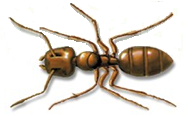 |
The
carpenter ant, of the genus Camponotus, are known as carpenter ants
because they house their colonies in galleries they excavate in
wood. Carpenter ants do not eat the wood they remove during their
nest-building activities, but deposit it outside entrances to the
colony in small piles. The wood is used solely as a nesting site.
The galleries of carpenter ants are kept smooth and clean, and are
not lined with moist soil as termite galleries are.
Carpenter ants, vary in size and color but are usually large (1/4-1/2
inch) and blackish. Occasionally, swarms of winged carpenter ant
reproductives will emerge inside a home. Carpenter ant swarms usually
occur in the spring and are a sure sign that a colony is nesting
somewhere inside the structure.
Carpenter
ants rarely cause structural damage to buildings, although they
can cause significant damage over a period of years because nests
are so long lived. |
Crazy Ant |
Crazy ants, Paratrechina longicornis (Latreille), occurs in large numbers in homes or outdoors. They often forage long distances away from
their nests, so nests are often difficult to control. The name "crazy
ant" arises from its characteristic erratic and rapid movement
not following trails as often as other ants.
The crazy ant worker is relatively small (2.3-3 mm). They are dark brown
to blackish (Creighton, 1950); the body often has faint bluish iridescence. |
Fire Ant
 |
Imported
fire ants are aggressive, reddish brown to black ants that are 1/8
to 1/4 in long. They construct nests which are often visible as dome-shaped
mounds of soil, sometimes as large as 3 feet across and 1 1/2 feet
in height. In sandy soils, mounds are flatter and less visible. Fire
ants usually build mounds in sunny, open areas such as lawns, pastures,
cultivated fields, and meadows, but they are not restricted to these
areas. Mounds or nests may be located in rotting logs, around trees
and stumps, under pavement and buildings, and occasionally indoors.
When their nests are disturbed, numerous fire ants will quickly run
out of the mound and attack any intruder. These ants are notorious
for their painful, burning sting that results in a pustule and intense
itching, which may persist for 10 days. Infections may occur if pustules
are broken. Some people have allergic reactions to fire ant stings
that range from rashes and swelling to paralysis, or anaphylactic
shock. In rare instances, severe allergic reactions cause death. |
Pharaoh Ant |
The
pharaoh's ant may be the most difficult of all building-invading
ants to exterminate. They have large colonies with multiple queens,
nest almost anywhere within a structure, and will split large colonies
into smaller ones at the slightest sign of stress.
Pharaoh's ants do not cause direct damage to the structures they inhabit,
nor are they known to harm humans by biting or are they carriers
of disease. They are a nuisance pest.
Pharaoh's ants are very small. They do not exceed 1/12" in length. They are yellowish to reddish brown in color. |
Centipede |
Centipedes
are reddish-brown, flattened, elongated arthropods with one pair
of legs attached on most of their body segments. The first pair
of legs is modified into poisonous jaws located below the mouth
to kill insects. Their antennae are longer than those of millipedes.
Centipedes feed on live insects and other small animals. They do
not damage plants.
They are a nuisance in household and basement. They feed on small insects such as cockroaches, clothes moths and house flies; do not damage food supplies or household furnishings. If crushed, they may bite, causing some pain and swelling. |
Millipede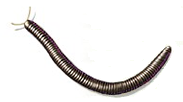 |
Millipedes
are slow-crawling, round-bodied pests which have two sets of legs
on each body segment. Millipedes develop best in damp and dark locations
with abundant organic matter (food). They often curl up into a tight
"C" shape, like a watch spring, and remain motionless
when touched. The body is long and cylindrical.
They are from 1-4 inches long and dark brown in color. |
American Cockroach |
Adult
American cockroaches are reddish-brown to dark brown (except for
a tan or light yellow band around the shield behind the head), about
1-1/2 to 2-inches long, and have wings capable of flight. Males
and females are about the same size.
American
cockroaches can be detected by examining the premises after dark
with a flashlight. They occur in dark, damp, warm places, often
near steam pipes, in sewers, grease traps, damp basements, etc.
During the day, probing hiding places with a wire will expose roaches.
Household sprays of pyrethrins applied to hiding places will flush
out roaches, sometimes killing them if they contact the spray. |
German Cockroach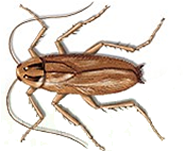 |
The
German cockroach is the cockroach of concern, the species
that gives all other cockroaches a bad name. It occurs in structures
throughout Alabama, and is the species that typically plagues multifamily
dwellings. German cockroaches adulterate food or food products with
their feces and defensive secretions, physically transport and often
harbor pathogenic organisms and may cause severe allergic responses.
The
adult is 10 to 15 mm long, brown to dark brown in color with two
distinct parallel bands running the length of the pronotum. The
sexes can be distinguished by the following characteristics: male
- body thin and slender, posterior abdomen is tapered, terminal
segments of abdomen visible, not covered by tegmina (leathery outer
wings); female - body stout, posterior abdomen is rounded, entire
abdomen just covered by tegmina. |
Smoky Brown Cockroach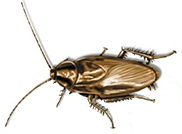 |
Smokey
Brown Cockroach, periplaneta fuliginosa, is a relative of the American
cockroach and resembles it in shape and size. These cockroaches
are more common in the southern United States.
They
are a little over 1 inch long, and both sexes have wings that are
longer than the abdomen. Their very dark mahogany colour is striking
; no light markings appear on the pronotum or wings.
Smokey
brown cockroaches are suceptible to losing moisture through their
cuticle, and so are usually found in damp, dark and poorly ventilated
environments. They rarely infest the dwelling part of buildings,
and are instead found in sheds, wall and roof spaces, sub-floors,
mulched areas, and in and around grease traps and drains. |
Earwig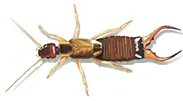 |
The
name originates from the superstition that earwigs crawl into the
ears of sleeping persons and bore into the brain. Although earwigs
appear somewhat dangerous due to their forceps, they are practically
harmless to man.
Earwigs
vary in size from 1/2-1" in length, they are brown to black
in color. Species may be winged or wingless. Only a few species
are good fliers. The body terminates in a pair of forceps. These
forceps or pincers are the earwig's most distinctive characteristic.
The forceps are used in capturing prey and mating. |
Ladybug |
Ladybugs,
harmonia axyridis, - are usually about 1/4 inch in length and round.
The wings are usually red or orange. Spots will vary. Ladybugs are
predators of aphids and other plant pests so they may be found on
a wide variety of plants outside.
As
the weather cools in late summer and early fall, the sun warms the
southern and western walls of buildings. The warmth attracts these
insects to buildings where they crawl inside cracks and stay there
for the winter. This would be fine, but during warm winter days,
some insects "wake up" and end up on the inside of the
building. |
House
Mouse |
The
House Mouse, mus musculus, - This familiar small rodent arrived
in North America in the baggage and stores of the early settlers.
House mice are prolific breeders: they reach sexual maturity at
35 days, and have several 21-day pregnancies per year, producing
4-7 offspring per litter. Chiefly nocturnal in activity, their food
consists of grains, fruit and vegetables, stored food, and refuse. |
Brown Recluse Spider
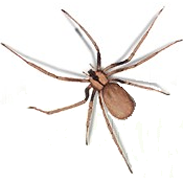 |
The
brown recluse belongs to a group of spiders that is officially known
as the "recluse spiders" in the genus Loxosceles (pronounced
lox-sos-a-leez). These spiders are also commonly referred to as
"fiddleback" spiders or "violin" spiders because
of the violin-shaped marking on the top surface of the cephalothorax
(fused head and thorax.
In
the mature brown recluse spider as well as some other species of
recluse spiders, the dark violin marking is well defined, with the
neck of the violin pointing toward the bulbous abdomen. The abdomen
is uniformly colored, although the coloration can range from light
tan to dark brown, and is covered with numerous fine hairs that
provide a velvety appearance. The long, thin, brown legs also are
covered with fine hairs, but not spines. Adult brown recluse spiders
have a leg span about the size of a quarter. Their body is about
3/8 inches long and about 3/16 inches wide. Males are slightly smaller
in body length than females, but males have proportionally longer
legs. Both sexes are venomous. |
House Spider
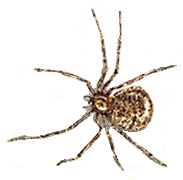 |
The
common house spider, Achaearanea tepidariorum (C.L. Koch), may be
the most abundant of the several species of spiders that live in
the company of man in the southeastern United States
Carapace
and sternum are yellow to brown, legs are yellow to brown with darker
rings; the abdomen is higher than long, is gray with black and white
pigment, and has a white spot behind the highest point, surrounded
anteriorly by black with dark lines running down the sides and black
chevrons behind; the venter has two light patches enclosing a darker
area; the male is darker and smaller than the female; females range
from 5 to 8 mm in length, while males are generally about 4 mm in
length |
Wolf Spider
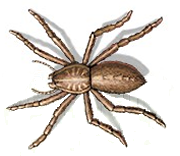 |
Wolf
spiders are usually large, hairy spiders that are not associated
with webs. They look much worse than they are.
Most
homeowners have misconceptions about spiders-they are pictured to
be poisonous (even deadly), and likely to attack at any time. Wrong.
The only dangerous spiders we have in Alabama are the brown recluse
spider and the black widow spider. For the most part, spiders are
beneficial, eating insects and other spiders. |
Cat Flea |
The
most common domestic flea is the cat flea, Ctenocephalides felis.
The adult cat flea, unlike many other fleas, remains on the host.
Adults require a fresh blood meal in order to reproduce.
The
dog flea, Ctenocephalides canis, appears similar to the cat flea,
but is rarely found in the United States. Cat fleas are commonly
found on both cats and dogs in North America, while dog fleas are
found in Europe.
In
order to effectively control an infestation, fleas must be removed
from the pet, the home, and the yard. Removal of fleas from the
animal alone is futile. Immature fleas which have developed into
adults off the animal simply jump on, causing subsequent reinfestation.
Flea combs may be used to treat the pet, yet they only remove ten
to sixty percent of the fleas. By shampooing the animal, the dried
blood and skin flakes which provide food for the larvae are removed. |
Bald-faced Hornet
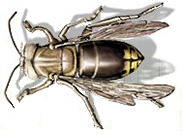 |
The
bald faced hornet (Dolichovespula maculata) is actually a large
yellow jacket and not a true hornet. Bald faced hornets make those
large, pear-shaped nests so often seen in trees after the leaves
have fallen in the fall. The paper covering of the nest is made
from chewed up wood or paper that the hornets will form into the
outside nest covering. They will attach their nests to trees, bushes
or sometimes even the side of a structure.
They
are 5/8-3/4" (16-20 mm). Head much shorter than wide; neck
and "waist" (pedicel) about equally constricted. Black
and white patterns on face, thorax, abdomen, and 1st antennal segment.
Wings smoky. |
Subterranean Termite (swarmer)
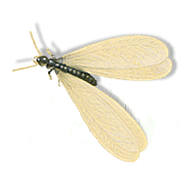
(worker)
(soldier)
(queen)
(king) |
Subterranean
termites are the most destructive insect pests of wood in the
United States. They cause more than $2 billion in damage each year,
more property damage than that caused by fire and windstorm combined.
In nature, subterranean termites are beneficial. They break down
many dead trees and other wood materials that would otherwise accumulate.
The biomass of this breakdown process is recycled to the soil as
humus. Problems occur when termites attack the wooden elements of
human structures -- homes, businesses and warehouses. Their presence
is not readily noticed because they hide their activity behind wallboards,
siding or wood trim.
Termite
workers make up the largest number of individuals within a colony.
Workers are wingless, white to creamy white, and 1/4 to 3/8 inch
long. They do all of the work of the colony -- feeding the other
castes, grooming the queen, excavating the nest and making tunnels.
In working, they chew and eat wood, causing the destruction that
makes termites economically important.
It is important to be able to distinguish between swarming termites
and ants. They often swarm around the same time of year, but control
measures for each differ greatly.
 |
Yellow Jacket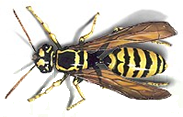 |
Yellow
jacket wasps live in nests. Problems usually occur when the wasp or
its nest is disturbed. They have the ability to sting as a means of
ensuring survival. A hollow stinger is located at the rear of the
yellow jacket's body. Upon penetrating the skin, a venom is injected
through the stinger. These stings can be quite painful. They can also
be very dangerous to people who have developed an allergy to the stings.
Unlike the bee, a yellow jacket can sting more than once. Wasps can
also damage fruit when they create holes by eating the flesh.
People
often mistake bees for yellow jackets because of their colouring,
however they are very different. Bees sting once and then die, but
wasps can sting repeatedly. Yellow jackets have a shiny black and
yellow body and measure 2 to 3/4 inch (12-18 mm) in length. These
social insects live in large caste-divided colonies. |
|